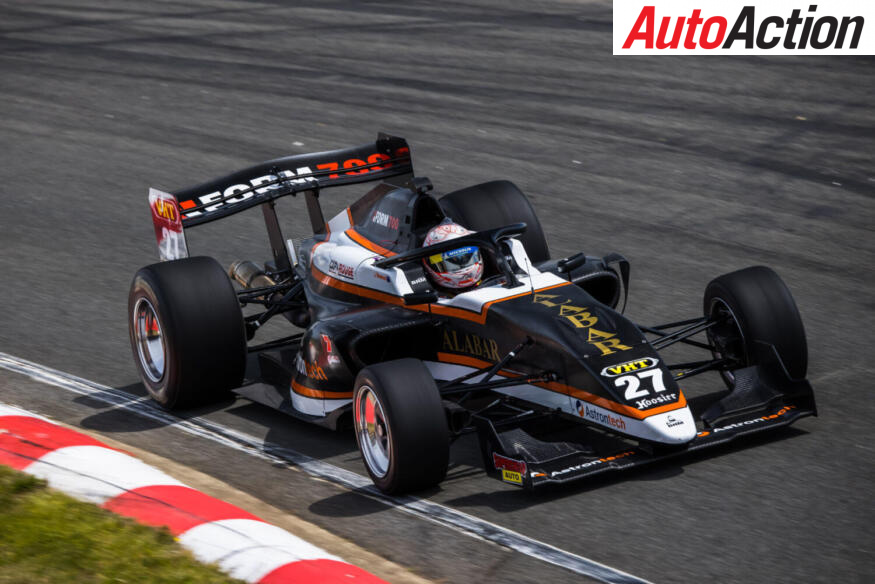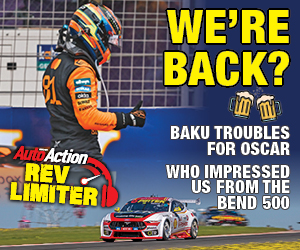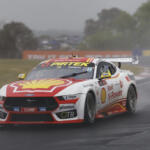HOW S5000 WAS BROUGHT UNDONE…

In his regular AA column this week, CHRIS LAMBDEN – who conceived S5000 – spilled the beans on exactly how, in his view, Australia’s latest Gold Star championship single-seater category was ‘put down.’
This is a compacted, edited version, with the full version in print and the digital edition.
FIRST UP, an apology. When I agreed to contribute a column to AA, with my pet project S5000 ‘in recess’, I did promise it would not delve into the issues confronting it.
However, the startling events of last week, with AASA announcing its plans to stage an ‘Australian Driver’s Championship’, and the subsequent negative commentary again stretching across social media, about S5000’s ‘failure to deliver’ or ’death’ compels me to put the facts out there.
S5000 didn’t die (and I hope it may yet re-launch). It was murder, your honour.
Between them, Supercars, Motorsport Australia, and even ARG itself, to varying degrees, all contributed to an extraordinary pile-on.
SUPERCARS, FUNNILY enough, was moderately okay to start with (remember, they thought enough of the concept to build a ‘copycat’ car of their own, albeit a disaster, at one point) and S5000 raced at the 2021 Bathurst 1000 event, at the tail end of COVID.
There were issues on that day, with constrained power, and a couple of needless crashes (on which more later), but the cars were still impressively fast – sub 2mins – challenging and above all safe. I guess that’s called racing.
January 2022 saw two big changes: Firstly, the takeover of Supercars by new owners RACE. At the time, ARG shareholders Brian Boyd (PAYCE) and Barry Rogers (GRM) each held around 14% of the new company and went in with well-intentioned plans to bring the whole of national-level motorsport together under one happy family roof.
(There were even clauses in the paperwork, which I have seen, referring to the potential for RACE to acquire ARG a couple of years down the track). The concept never materialised and the relationship between the parties soured.
At the same time, along came the Supercars Superlicence scandal. Despite any points you might earn racing in other national-level categories, you would need to complete a season of Supercars Second-hand Car category, Super2, before you could race a Supercar.
That protectionist and discriminatory policy has been discussed and protested to death ever since, with Motorsport Australia seemingly unable to do anything about it until very recently when, of all things, the FIA – reacting to a complaint from the owners of the FIA TCR series, similarly affected – pushed both parties for change.
But the solution – reverting to a points qualification system – is so utterly slanted towards Super 2 and Super 3 (was that really just two Super 3 entries at Bathurst last month?), and against other selected categories, that it’s actually worse. MA needs to react and fix it … now.
The pub test? Double Gold Star Australian Drivers Champion Joey Mawson STILL doesn’t qualify. Give me a break …
I’ve also grown tired of reeling off the long list of former Formula Holden contenders/champions – including RACE Board member and TV commentator Mark Skaife – who then moved directly to V8 Supercars and didn’t manage too badly …

Joey Mawson, double Gold Star champion, still doesn’t qualify for a Supercars Superlicence. Image ARG/KALISZ
MOTORSPORT AUSTRALIA? It’s hard to figure them out sometimes. Bureaucracy has always puzzled me (although I’ve even been part of it on rare occasions!).
The fact is that S5000 has been selectively and discriminatively hit with technical and event restrictions which have simply not been applied to other Australian racing categories.
When S5000 raced at Bathurst in 2021, it was with horsepower slashed – to meet an FIA ‘Grade 3’ circuit weight-to-power minimum (2:1) guideline which MA said was absolutely non-negotiable.
In the end, ARG complied and the cars raced, with 80hp electronically removed. With the car’s inherent drag, it meant speeds on Con Rod were barely over 280kmh, slower than Supercars, Super2 and, embarrassingly, even a couple of venerable Touring Car Masters cars! It was pathetic – though they still lapped under 2mins … The cars simply couldn’t pass on Con Rod and that, in my view, ultimately contributed to the couple of high-profile incidents at The Chase.
Boys will be boys (or should that be ‘persons will be persons’ …). But the cars performed superbly, safety-wise, throughout. Perfect.
“Non-negotiable” we’d been told. Four months ago, Sports Sedans (good on ‘em by the way) raced at Bathurst – with, in some cases, 7-800hp powering 1000kg cars. Do the maths. MA personnel I’ve queried this apparent contradiction with simply shrug and mumble …
A few months later we heard that S5000 was indeed going to be banned from Bathurst – on safety grounds.
I asked to attend and contribute to the relevant MA ‘Risk Management Committee’ discussion but was told it was not possible. “Send us something in writing.”
I did, pointing out that, in fact, S5000 was currently the safest category in Australian motorsport. 51 races at the time (now 60) completed; no car has ever come close to rolling over (car weight and minimal tyre-to-tyre friction/grip being a technical factor), never mind barrel-rolling into the crowd.
No driver has been injured. Not a scratch.Nothing. Nil. Zero. I included images of an Aussie Race Car barrel-rolling over the fence at Bathurst, noting that Aussie Race Cars still race at Bathurst. No S5000 has ever rolled or come closed to it.
The meeting was, however, swayed by a prominent and vocal Supercars identity who – despite the obvious conflict of interest, and absolutely no direct experience with open-wheel race cars – lectured the group on ‘interlocking wheels’ in open-wheel race cars and the high risk of an S5000 car spiralling off into the crowd … S5000 was thus banned from Bathurst – the only category treated thus.
I appealed to MA, again highlighting the total safety of the cars, that no car had ever even rolled, blah, blah, and was, this time, informed that FIA Simulations had identified risk.
Really! Simulations involve making a pile of assumptions, because actual facts don’t exist. F1 teams do extensive pre-race simulations for each race, which become null and void the moment the cars hit the track for P1 at each GP. As F1 commentator and ex-racer Martin Brundle puts it, perfectly, “simulations are okay, but it’s real cars on real race tracks that matters.”
I pointed this out (in writing of course), re-iterating the factual data of S5000’s perfect safety record. I asked for a re-evaluation based on the facts.
Didn’t get a reply.
Can you see where I’m going with this? For some reason, MA has an uncomfortable ‘set’ against S5000. It’s okay for 800hp Sports Sedans and barrier-jumping Aussie Race Cars to compete at Bathurst, but the category with the best safety record in the country can’t? Why?
I’ve always shared the feeling that no-one at MA wants to upset the barrel with the FIA. We’re affiliated to the FIA, not owned or run by it. But there’s an almost religious deference to the FIA, that nothing should be challenged – or sensibly adapted for Australian conditions. And for some reason – maybe it’s that S5000 as a single-seater category doesn’t quite ‘fit’ with the FIA’s formal F4/3/2 pathway to F1 – it’s S5000 which has been singled out and ‘discouraged’ …
Right now, there’s a new CEO at MA, and a new Technical and Safety Director is being appointed. To me, that’s a golden opportunity to re-evaluate how the organisation thinks and operates. Maybe.
AND THEN there’s been ARG itself. It was its long-departed first CEO who thought it a good idea to ditch free-to-air TV (SBS) for a few bucks from a pay TV channel – that not a lot of people watch – with a week’s notice.
Yes, a week before the opening S5000 race of 2022, teams and drivers who had sold their sponsors on free-to-air discovered it wasn’t. The TV audience dived overnight. Over the following two seasons, the drift away of sponsors across ARG was palpable.
This, at least, has now, just, been fixed – credit MA, which has retained the TV rights and done its SpeedSeries deal with Seven/7Plus. Great news, but maybe a little late – not only for S5000, but for other key ARG categories which suffered a steady numbers decline over the past two years directly as a result of that badly-advised pay TV deal …
PUT ALL that together and you can see how, over the past 18-24 months, S5000 has had very little to offer an ambitious young racer, which is why, in my view, entry numbers stalled.
I have dealt with numbers of enquiries from drivers who love the S5000 concept … But then the discussion has turned to: Crap TV audience for the sponsors; the total barrier to progress to Supercars if successful (viz Joey Mawson); loss of two major events – Bathurst and, ah yes, the Grand Prix. And so on.
Not much to offer.
Ah yes, the AGP. After a successful, full-grid event at the 2022 AGP, fast-forward 12 months and, for some reason, the GP Corporation, which sells-out its event tickets within days, agrees to fork out what must be $5m+ flying 52 F2/F3 cars from Europe to dominate the support program. S5000 is out (and Supercars is left to deal with being fourth-in-line support event!).
YOU may now be starting to understand why I don’t accept that S5000, in itself, ‘failed’. It has actually been crushed – by a combination of the conflicted parties, constraints and bad decisions outlined above. Some of it is pretty ugly, but it is why numbers struggled to grow over the past two years and has resulted in GRM currently ‘parking’ the fleet.
I’ve been in and around this sport, here and in Europe, since I was 14 (which, yes, is a while) and generally had a ball, but I have never, ever seen such a concentrated effort by elements within a sport to bring something down.
My other frustration is that the S5000 car itself is a tremendous example of the very best motorsport engineering available in this country. Its creation was overseen by Michael Borland, with key input from Roger Higgins (InnoV8) on the engine side, Holinger Engineering and MoTeC.
A brilliant all-Australian combination. Then GRM got involved – $6m+ in first-up investment, ‘productionising’ things, and building 18 superb race cars. I’m disappointed for all of them – they created such a terrific all-Australian car yet have had to watch on as it has slowly and deliberately been dragged down.
WHAT NEXT? I retain the hope that – with the key barriers hopefully taken down, S5000 might just successfully relaunch. We’ll see. Summer series anyone?
But when, after all that, I’m confronted with the news that AASA looks to have hijacked the Australian Drivers Championship, and intends to run it using, with respect, what is a solid, economical, bike-engined club race car, I don’t know whether to laugh or cry …
-CHRIS LAMBDEN
There’s lots more loaded into a bumper edition of AUTO ACTION magazine, on sale at newsagents and available digitally here.
For more of the latest motorsport news, subscribe to AUTO ACTION magazine.
Latest Podcast: Hats off to you. It’s the Auto Action Rev Limiter
Hooray, F1 is back. Boo, Max Verstappen wins. The Bahrain Grand Prix was a little underwhelming, but at least there was racing… and scandal. There was plenty of scandel, but we don’t do that stuff apparently, so we don’t talk about Red Bull Racing, Christian Horner and Jos Verstappen.







